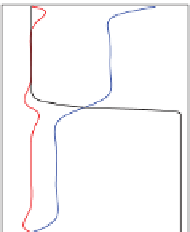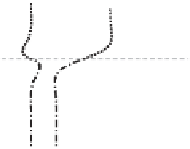Geoscience Reference
In-Depth Information
700
700 supposing axisymmetric flow. Axisymmetric
flows still allow for Ekman circulation. The Reynolds
number is defined as
R
e
=
L
2
/ν
and is approximately
3500. At
t
= 0 the interface is sharp in density and shear.
After 18 rotation periods, there is a uniform azimuthal
flow in the interior and an Ekman boundary near the
interface, as can be deduced from the relative strength of
the radial velocity and a variation in azimuthal velocity
corresponding to an Ekman spiral. The dot-dashed lines
in Figure 11.7a are the velocity profiles as obtained for
a classical Ekman layer near a no-slip and zero vertical
velocity boundary at the interface, such as for a virtual
wall. The perfect agreement between the analytical solu-
tion and the numerical result confirms that indeed there
are internal Ekman layers above and below the interface.
The streamlines and vorticity lines in Figures 11.7e and
11.7f show the Ekman layers at each side of the inclined
interface in space. In this simulation Ro is not very small
(i.e.
×
(a)
(b)
0.35
0.3
0.3
υ
θ
0.25
0.2
0.2
ρ
ρ
0.15
0.22
υ
θ
0.2
0.1
0.1
υ
r
0.18
υ
r
0.16
0.05
0.14
-0.01
0
0.01
0
0
0
0.5
1
0.00
0.50
1.00
(c)
(d)
0.28
6
Sc = 7
Sc = 20
Sc = 700
Sc=7
Sc=20
Sc = 700
0.24
5
0.20
4
0.16
3
0.12
2
0.08
1
0.04
0
0.48) allowing for some vertical motion and an
inclination of the interface (see Figures 11.7e,f).
With increasing interface thickness, the radial veloc-
ity and therewith the Ekman pumping reduce in strength
such that the flow tends to a unidirectional shear flow,
for very thick interfaces. Especially for small Schmidt
numbers, diffusion eventually weakens the density gradi-
ent so that the stratification and consequently the Burger
number decrease. For such small Schmidt numbers the
interface is a transient. It inclines more and more with its
diffusion, until eventually the fluid is mixed and shear lay-
ers are represented by Taylor columns. The interaction of
the front with top and bottom solid boundaries and the
consequent transport of interfacial fluid via the horizontal
and vertical boundary layers enhance the mixing. The evo-
lution is then determined by the limited geometry of the
annulus. To consider only the interface dynamics, the sim-
ulations are evolved for the time the density transport via
the Ekman and Stewartson layers does not significantly
affect the density in the bulk of the layers.
Figures 11.7c,d show the interface thickness in density
and shear (Figure 11.7c) and the interface thickness ratio
R
=
δ
ν
/δ
κ
as a function of time for different Schmidt num-
bers (Figure 11.7d). These thicknesses are obtained from
fits with a tanh profile. For all Sc
>
1, the initially very thin
density interface increases more or less rapidly in thick-
ness, thus reducing the value of
R
, and eventually reaches
a value between 1 and 2. Due to entrainment, the density
interface thickness stops growing while the shear thick-
ness continuously increases. The interface thickness ratio
R
increases to values close to or higher than 2 if we fol-
low the tendency of Figure 11.7d. This evolution shows
that the diffusion of vorticity and density across an inter-
face in a rotating fluid is not a linear diffusion problem but
is governed rather by entrainment, leading to an eventual
larger shear thickness than density thickness.
≈
0
0 102030405060708090100
0 102030405060708090100
Time (adimensioned units)
Time (adimensioned units)
(e)
(f)
0.3
0.3
0.2
0.2
0.1
0.1
0
0
0.4
0.6
0.8
1
1.2
0.4
0.6
0.8
1
1.2
Figure 11.7.
Properties of the Ekman layer with azimuthal and
radial velocity and density profiles at mid radial position in
the annulus after 18 rotation periods for (a) Ro = 0.4861 and
Re = 3500 and (b) Ro = 0.0046 and Re = 547.6. The dot-
dashed lines represent Ekman layers for a virtual boundary at
the interface (the position of the interface is indicated in dashed
grey). (c) Interface thicknesses
δ
v
(
) nondimensional-
ized by
L
for Schmidt numbers 7, 20, and 700 and (d) their ratio
R
=
δ
v
/δ
ρ
. In (e) and (f) are shown, respectively, the stream-
lines and vortex lines along a
r
,
z
cross section. The contours of
rv
θ
are in the range [-1,1] from white to black and background
shading for density. Numerical parameters for (a), (e), and (f):
N
θ
×
◦
)and
δ
ρ
(
•
700 and
g
= 0.06, Bu = 0.3147,
N
r
×
N
z
=1
×
700
×
Sc = 700.
separated by a diffuse interface, the existence of such
internal Ekman layers is not obvious. For the study of
the instantaneous density and velocity profiles, we con-
sider this problem numerically. Since the interface has
no discontinuities and only axisymmetric stable flows are
considered, the numerical modeling is adequate to capture
thephysicsofthelow.
Figure 11.7a shows the profiles of azimuthal velocity,
radial velocity, and density of a simulation with high
Reynolds number and Sc= 700 for a resolution of 1
×






















































































































































































































































































































































































































































































































































































































































































































































































































































































































































































































































































































































































































































































































































































































































































































































































































































































































































































































































































